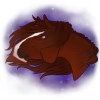"Phantom Spots" could also be called phantom roaning, selective roaning, reverse calico, or vanishing roan
When roan and pinto genes (tobiano, tovero, and manchado specific) interact, it is possible for the roaning to become selective, appearing only on a few spots on the main body of the horse. It's important to note that the presence of the roan gene is necessary for these phantom spots to appear, and they will not be present on the lower legs and head of the horse.
Phantom spots can vary in size, with some taking up to 3/4 of the horse's pinto spots, although it is more common for them to affect up to 1/2 of the spots. Additionally, the roan gene can cause more extensive mapping on all of the pinto spots. The color of the phantom spots can range from nearly white to nearly the base color, as long as there is some distinction between the main body color and the roaning.
Khims Marking Contest - INK by Inkiing
| Based on | Click to view |
| Artist | Inkiing [gallery] |
| Time spent | 50 minutes |
| Drawing sessions | 1 |
| 9 people like this | Log in to vote for this drawing |
3 posts
• Page 1 of 1
Khims Marking Contest - INK
Inkiing "Ink"
he/him * adult player
he/him * adult player
Wanna Support My Art?
Deviant Art!
i do not handle any USD sales over CS, please refer to DA to do so
Custom Species Base!
Horse Genetics Guide
Deviant Art!
i do not handle any USD sales over CS, please refer to DA to do so
Custom Species Base!
Horse Genetics Guide
-

Inkiing - Posts: 3286
- Joined: Tue Oct 17, 2017 2:26 am
- My pets
- My items
- My wishlist
- My gallery
- My scenes
- My dressups
- Trade with me
Re: Khims Marking Contest - INK
Thank you for entering 


My Art Shop
UR Tiger Dog up for Offers!
I am a Breyer and Schleich collector along
with other brands of all sizes - mainly horses
looking for UR bengal (ultimate dreamie)
b-day is Jan 3rd, I'm a Capicorn♑

-

Rescue2001 - Posts: 18302
- Joined: Tue Nov 04, 2014 1:06 pm
- My pets
- My items
- My wishlist
- My gallery
- My scenes
- My dressups
- Trade with me
Re: Khims Marking Contest - INK
Congrats on being the winner, please let me know what rarity your wanting this gene to be 


My Art Shop
UR Tiger Dog up for Offers!
I am a Breyer and Schleich collector along
with other brands of all sizes - mainly horses
looking for UR bengal (ultimate dreamie)
b-day is Jan 3rd, I'm a Capicorn♑

-

Rescue2001 - Posts: 18302
- Joined: Tue Nov 04, 2014 1:06 pm
- My pets
- My items
- My wishlist
- My gallery
- My scenes
- My dressups
- Trade with me
3 posts
• Page 1 of 1
Who is online
Users browsing this forum: Amazonbot [Bot] and 8 guests







